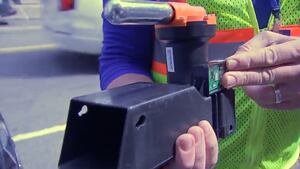
Boston 25 News got an up close and personal look at new rodent-killing technology being tested in sewers along Boston’s Italian mecca on Hanover Street.
27 mechanical sewer traps installed underneath manholes have resulted in about 60 rat kills in 60 days.
It’s the first major deployment of this new technology in the United States.
Jeffrey Weisberg, with A1 Exterminators, was selected by the city of Boston for the pilot program that involves sewer traps in the North End.
Some are installed more than 25 feet below the ground.
The smart digital technology, already being used in some European countries, sends a communication signal via Bluetooth every time a rat perishes.
“The rodents basically have no way to get by the trap. When they go in, they have to trigger them,” Weisberg told Boston 25 News. “It comes through on an app on our phone, which we can see in real time the activity.”
Weisberg said the brick line, low-flow sewers in the North End are conducive tor rat burrowing, nesting, and traveling.
He believes the sewer traps would be beneficial in other Boston neighborhoods.
“This is a way to document, not just the visual findings and guessing. This is hard data on what’s active and where,” he said. “We know within 60 seconds of a kill.”
A1 Exterminators is also working with the city to install new surface traps in Chinatown in September.
Those surface traps are equipped with a CO2 cylinder that fires a non-toxic piston.
For the first time ever, the city is now measuring the rodent population itself with more than 250 censors installed citywide.
“We are currently in the middle of trying to understand what our baseline is, how many rodents are we actually seeing at these hotspots,” said Boston Inspectional Services Commissioner Tania Del Rio. “Now we need to collect four weeks of really clean data to understand what our baseline is.”
Del Rio said that data will lead to a few new neighborhood interventions in the months ahead using additional high-tech tools.
“We’re really excited about our new burrow RX machines they utilize carbon dioxide which actually smokes the burrows,” she said.
Del Rio emphasizes that the city cannot exterminate its way out of this issue.
“The more a rat has to eat, the more they can reproduce, and they can reproduce really quickly,” she added.
Boston’s Rodent Action Plan involves on-going input from neighbors across the city.
Boston 25 News has reported on an uptick in rodent 311 complaints this summer, including rat sightings during daylight hours.
Some neighbors are doubtful that any strategy will have an impact in neighborhoods that don’t containerize their trash.
“I just had one run over my foot on trash day. It’s insane,” said North End resident Mike O’Brien. “They’re huge. They look like kittens running around.”
Residents in tightly packed communities, including the North End, the South End, and Beacon Hill, don’t have room for trash bins in many apartment buildings.
Some believe the city should stop allowing people to leave trash bags out the night before pickup.
The city of Boston is still collecting feedback from neighbors through a series of community meetings.
This is a developing story. Check back for updates as more information becomes available.
Download the FREE Boston 25 News app for breaking news alerts.
Follow Boston 25 News on Facebook and Twitter. | Watch Boston 25 News NOW

